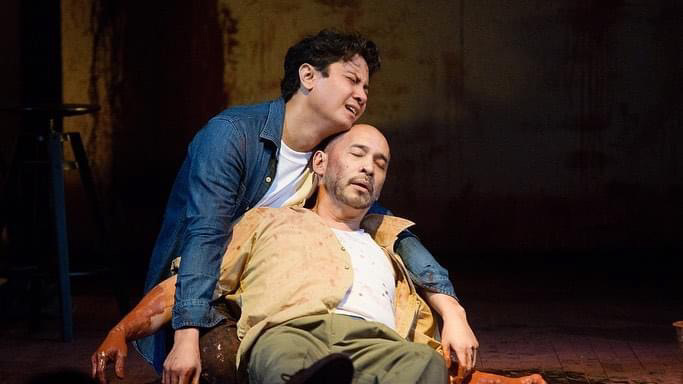
REVIEW: ‘Red’ asks difficult questions about the “why” of art
RED’s 2023 production takes place in the zeitgeist of A.I. art. Ten years ago, the sort of ‘art’ generated by AI was the stuff of sci-fi films. Today, anyone can ‘create’ ‘art’ in a matter of seconds with the right tools.
But is it art? Can just anyone make something–even in minutes or seconds–and be deemed an artist? RED is a play that challenges its viewer to come up with an answer.
It is a rare play that makes one ponder what one believes to be art, who decides what art is, and what kind of role the artist has in a modernized nation embracing technology. It is a rare production that invites such critical self-examination from all who see it.
Fiery Demands
It’s like walking inside a chapel. Abstract expressionist artist Mark Rothko (played by Bart Guingona) lounges on a chair, staring off into the void as the audience troop inside. Dim lights evoke the feeling of intruding into a private sanctum.
When the clock struck showtime, Guingona smoked a (live) cigarette and turned the house lights off. His new assistant, Ken (JC Santos) arrives, immediately winning audience members over with his fresh-faced innocence to match his freshly scrubbed outfit and shoes. This contrasted immediately with the older artist’s paint-splattered clothes that, from a distance, looked as if they were splattered with blood. Perhaps that was indeed the intent: to show that blood, sweat, and tears go into such complete devotion to the muse.
“Lean forward. Engage with it.” Guingona orders as he physically manhandles Santos, demanding the younger man take a closer look at his latest mural, one of thirty or forty possible interior decorations for the Four Seasons Restaurant in the Seagram Building.
He might as well have been talking to the audience, for the play demands much from its viewer. It assumes the audience member is familiar with the basics of art history, knowing the difference between cubism and expressionism, as well as preliminary knowledge of the Greek pantheon of gods.
This sends a clear message about the production’s intent: we are not here to merely entertain the masses. Watching this show, it reminds audiences that theater is, in fact, soul-forming work.
The Tensions in Art and Life
Jazz versus classical music. Creativity against order. Passion unchecked, intellect reigning supreme. Youth replacing the old generation. All these dichotomies were personified by the two artists, the younger Ken reacting against the older Rothko.
It’s ninety minutes of highly elevated intellectual and artistic discourse, beginning with Rothko testing his apprentice’s ability to see, his educational background and familiarity with literary greats, not just visual artists.
Having weighed and measured his apprentice, finding him wanting, Rothko then lectures and preaches, letting Ken do most of the carpentry and paint mixing work. And then, when the great senior finally picks up the brush to paint, he freezes and reveals the great wound that he has hidden beneath spiteful pride: he can no longer see color, only black. The anguish of aging has depressed him to the point that he no longer sees vibrant colors, nor take joy in life. For Rothko, there is only the dark pit reserved for artists who no longer have anything relevant to offer the world.
From the very start we sense animosity from Rothko as he rails against the sweet-natured Ken, insulting his youth, his generation’s lack of artistic integrity and preoccupation with producing kitsch, or substandard art produced mainly for commercial profit.
Rothko piles on the verbal abuse until, like Zeus castrating his father Cronus, Ken finally snaps and launches a painful tirade of his own, pointing out the hypocritical tension that consumes Rothko’s life: how artists need patrons’ money, even as they seek to create art that transcends their vulgar origin.
A highlight for me was Sound Designer Jose Buencamino’s choice to play Mozart’s Requiem mass in the culminating scene, which serves as a fitting aural background as foreshadowing for the real end of Rothko, and symbolizing his generation’s demise.
The Script is the Star
Golden lines abound in a gorgeous script that has a quotable quote every other line. For anyone who’s ever wanted a passionate defense of art for art’s sake (made to expand one’s soul and not for commercial gain), this text is your bible.
However, the execution fell short of the extreme heights of expression that the script demanded. I remained largely unmoved even during the climactic moments of the play. The tempo of the dialogue’s back-and-forth seemed also too fast, too scripted. Guingona’s cynical drawl at times bordered on monotony. Santos displayed more varied colors and range, though I got the impression that he was underplaying it as well.
Santos and Guingona’s artistic choices indicate a more intellectual approach to the play, never fully committing their emotions to the tragedy unfolding onstage. Ultimately, that’s what the play ran on: an erudite script only competently performed. To use lines from the play, there was more Apollonian intellect than Dionysian passion onstage, greatly disturbing our minds but rarely touching our hearts.
Then again, “We love them because they love their art so much.”, as John Logan once said. While RED’s ambitious idealism runs the risk of preaching to the choir, with its target audience seeming to be fellow artists or artists-in-training, to watch this play is to be challenged in the best way, and reminds us that true art appreciation always includes wrestling with difficult material.
In a landscape threatened by the rise of even more commodified art thanks to AI, RED reminds us of the requisite human struggle behind the real thing, making it of infinitely more value than any kitsch knock-off.
Tickets : P800.00 – P1,800.00
Show Dates: June 9-11 and 16-18 (3:30 and 8:00 pm)
Venue: PETA Theater Center, New Manila
Running Time: 1 hour and a half (no intermission)
Credits: John Logan (playwright), Bart Guingona (Director), Mark Daniel Dalacat (Associate Direction & Production Design), Gabo Tolentino (Lighting Design), Satya Edilo (Associate Lighting Design), Jose Buencamino (Sound Design)
Cast: Bart Guingona (Mark Rothko) and JC Santos (Ken)
Company: The Necessary Theatre


Comments